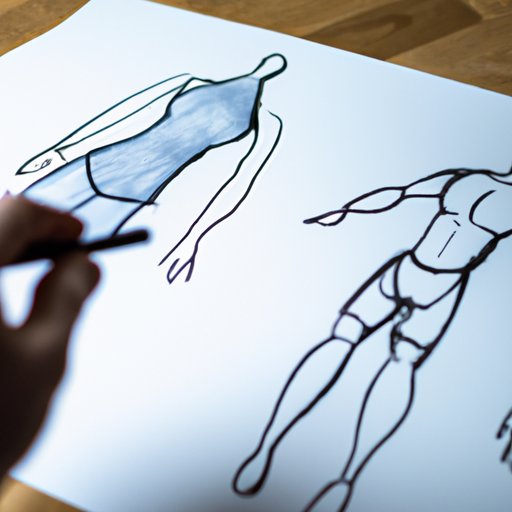
Introduction
Humans are one of the most commonly depicted figures in art. From ancient cave paintings to modern-day masterpieces, humans have served as a subject, theme, and inspiration for artists everywhere. Learning how to draw humans is important for all aspiring artists, whether you want to create realistic portraits, cartoon characters, or abstract representations. In this article, we’ll provide a complete guide to drawing human figures, from basic shapes to complex anatomy and portraits.
The Beginner’s Guide to Drawing the Human Body
Before you can start drawing complex human figures, it’s important to understand the basic principles of proportion, perspective, and shading. Proportion refers to the relationship between different parts of the body, while perspective refers to the way that objects appear to the eye based on their position and angles. Shading adds depth and dimension to your drawings, creating the illusion of light and shadow.
To start drawing humans, begin by sketching the basic shapes that make up the body, such as circles for the head and joints, rectangles for the torso and limbs, and ovals for the hands and feet. From there, you can add more details and refine each shape to create the desired pose. Look at references and observe how the body moves and changes in different positions and postures. Practice creating basic pose sketches to familiarize yourself with the body’s proportions and shapes.
Step-by-Step Tutorial: Drawing a Realistic Human
To create a realistic human figure, it’s important to observe and understand the human anatomy. This means studying the various muscles, bones and other anatomical structures that make up the body. Before starting to draw a realistic human, find references, either from real-life models, photos or video tutorials, to guide your drawing. Once you have a reference, break down the drawing process into smaller steps. Start with simple shapes and gradually add more details to your drawing. Pay attention to the shading, highlights, and blending techniques that help create a realistic 3D effect.
You can then use these steps to create your own step-by-step tutorial for drawing a realistic human. Start with the basic shapes, refine the proportions, and then add in details and shading. It’s essential to take your time during the process and to not get frustrated when it doesn’t come out the way you envisioned it. Practicing is key to get better with skill and time.
Mastering Human Anatomy: Tips and Tricks for Artists
Understanding human anatomy is essential for creating realistic and believable human figures. Artists should have a basic understanding and knowledge of human anatomy, including muscle groups, skeletal system, and how the body moves. To help boost your knowledge, use reference materials, such as books, anatomical models, and online resources. Attend life drawing sessions and feel free to ask for help from other artists or instructors on where to start.
Once you have a solid understanding of anatomy, apply that knowledge to your drawings. Identify the major muscle groups and bone structure of your figure, and use that knowledge to create accurate proportions and movements.
Unlocking the Secrets of Sketching Human Figures
Sketching human figures is another great way to improve your drawing skills and capture the essence of the human form. There are several techniques for sketching humans, including gestural drawing, contour drawing, and quick sketches. With gestural drawings or sketches, the emphasis is on the overall pose and gesture of the body, using loose and quick lines to portray the movement. With contour drawing, your lines are usually more detailed and descriptive, a good exercise to practice finding the right contours and shapes for each part of the body, without too much shading or details.
Whatever technique you choose, it’s important to practice observing humans and their movements every chance you get. Carry a sketchbook and practice with your friends, family or even strangers in public areas. Even quick sketches help you refine your skills, when it comes to proportion, gesture and body language.
From Stick Figures to Portraits: How to Improve Your Human Drawing Skills
Drawing humans is a skill that takes time, patience, and practice. Not everyone starts with mastered skills, but anyone can improve their skills through practice. Start with simple stick figures and progress to more complex shapes and poses over time, with plenty of practice to perfect your style and technique. Seek feedback from other artists, and don’t be afraid to experiment with different mediums and styles. Find your niche, and continue to grow and learn as an artist.
There are many success stories of famous artists who started with simple skills and improved them over years of hard work and dedication. Don’t give up on your dreams and passions, because with enough tenacity and skill-building, you too can become a professional artist.
Conclusion
Drawing humans requires patience, attention to detail, and practice, like anything in life. However, with the right techniques, knowledge, and tips, anyone can learn to draw realistic and engaging human figures. Starting with basic shapes and proportions, mastering anatomy and techniques, and continuing to build your skills daily will help take your talent to an exceptional level.
Resources
If you’re interested in learning more about human drawing skills, there are plenty of resources available online and offline, such as books, tutorials, and how-to videos. Some of our recommended resources include online drawing challenges, free handouts for anatomy and drawing classes, and many social media resources, inviting feedback and expert techniques with skill improvement.




